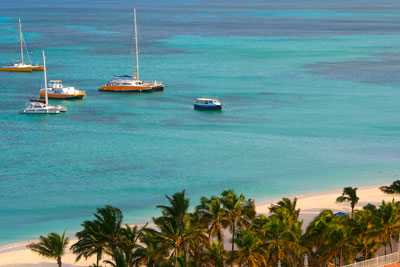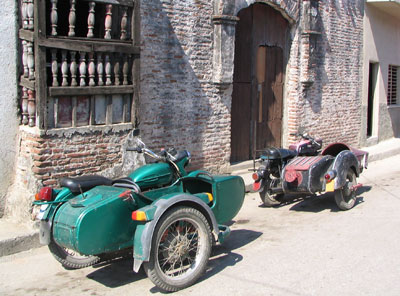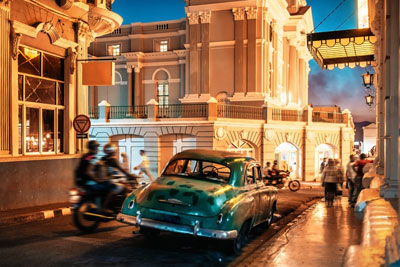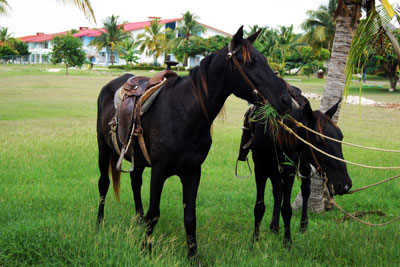Havana
 Havana, The capital of Cuba, is, with over 2 million inhabitants, the most populated but at the same time the smallest province of Cuba. It is the largest city in the Caribbean region with fantastic colonial preserves. Old Havana, one of its 15 districts, is a UNESCO World Heritage site since 1982. Havana has something for each taste: landscape and ecotourism activities, city tour, golf course with international tournaments, international marinas, the Havana Carnival, the International Ballet Festival and the International Festival of New Latin America Cinema (Hotel Nacional). In the pre-revolution times, Havana was considered as the queen city of the Caribbean because of its cultural strengths and its nightlife. This situation somehow disappeared but much has however remained, like the famous Tropicana shows. In July, Cubans show great expressions of their culture in dance and song.
Havana, The capital of Cuba, is, with over 2 million inhabitants, the most populated but at the same time the smallest province of Cuba. It is the largest city in the Caribbean region with fantastic colonial preserves. Old Havana, one of its 15 districts, is a UNESCO World Heritage site since 1982. Havana has something for each taste: landscape and ecotourism activities, city tour, golf course with international tournaments, international marinas, the Havana Carnival, the International Ballet Festival and the International Festival of New Latin America Cinema (Hotel Nacional). In the pre-revolution times, Havana was considered as the queen city of the Caribbean because of its cultural strengths and its nightlife. This situation somehow disappeared but much has however remained, like the famous Tropicana shows. In July, Cubans show great expressions of their culture in dance and song.
Before the 1959 revolution, this city was a basin of tourists from the USA, attracted by the climate, the nightlife and the history of the island. After the revolution, Castro’s socialist government redirected Cuba’s resources toward the improvement of living conditions in the rural areas of the country. However, rehabilitation projects that began in the 1980s brought some new visage to the city, particularly Old Havana.
Prior to the revolution, Havana was economically and ethnically divided between the minority of the rich, well-educated elite together with an upper and expanding middle class, and the majority of working-class citizens. Based largely on ethnic background where whites are generally rich and blacks and mulattoes generally poor, this economic separation did not provide opportunities to black and mulattoes to grow and to obtain adequate education. With the 1959 revolution, the Castro government changed the system and education and employment opportunities were made available to all Cubans, regardless of their ethnic backgrounds. Cuba follows a policy of no discrimination based on ethnic background.
It is important to note that Cuban Immigration, since spring 2014, systematically stamps all passports when entering and leaving Cuba. As well, the Cuban Departure Tax is no longer paid at destination since May 1st, 2015. It is now included in the price of your trip when buying a tour, vacation package or flight to Cuba
In October 2013, The Cuban government announced its intention to eliminate the dual-currency system, which is unique in the world. The Convertible Peso (CUC) will be wiped out and the Cuban Peso (CUP) will become the official and unique currency. However, the official date has not been revealed yet.
Want to order a tour to this city? Click here
Varadero
 Located on the 20-km long Hicacos peninsula, at 140 km from Havana, Varadero is the largest resort in the Caribbean and remains, with a huge and long path of hotels, shops, water activities and poolside entertainment, at the forefront of the tourism industry of Cuba. Also called Playa Azul, it is the urban center of the province of Matanzas and it offers a large, tourist-friendly place which is essential to the Cuban economy. The extremity of the peninsula, Punta Hicacos, is the most northern point of Cuba and the closest to the USA. It is covered by a natural reserve with primeval forests and beaches.
Located on the 20-km long Hicacos peninsula, at 140 km from Havana, Varadero is the largest resort in the Caribbean and remains, with a huge and long path of hotels, shops, water activities and poolside entertainment, at the forefront of the tourism industry of Cuba. Also called Playa Azul, it is the urban center of the province of Matanzas and it offers a large, tourist-friendly place which is essential to the Cuban economy. The extremity of the peninsula, Punta Hicacos, is the most northern point of Cuba and the closest to the USA. It is covered by a natural reserve with primeval forests and beaches.
Varadero is first of all a tourist destination with more than a million of tourists per year. It was considered as an elite destination, but after the revolution, the zone was opened to the Cuban population and the rich owners were expropriated. Although Fidel Castro was against the development of the tourist sector in the island, considered as symbol of the capitalism decline, he accepted its rise from the 1990s as the country was struck by the economic crisis. Luxurious hotels were then constructed in Varadero that has then stopped to be a wild beach for the Cuban population but a wide and developed place for foreign tourism.
Want to order a tour to this city? Click here
Camaguey
 Camaguey is a municipality in Central Cuba and the country’s third largest city with a population of more than 321,000 inhabitants. It is the capital of the Camagüey Province. It was founded under the name Santa María del Puerto del Príncipe in 1514 by Spanish colonists led by Diego Velázquez de Cuéllar. There are many myths around the many blind alleys and forked streets in the city of Camaguey, but the inhabitants think it was just developed without planning.
Camaguey is a municipality in Central Cuba and the country’s third largest city with a population of more than 321,000 inhabitants. It is the capital of the Camagüey Province. It was founded under the name Santa María del Puerto del Príncipe in 1514 by Spanish colonists led by Diego Velázquez de Cuéllar. There are many myths around the many blind alleys and forked streets in the city of Camaguey, but the inhabitants think it was just developed without planning.
The clay pot (or Tinajón), called “Kanari” in Haiti is the symbol of the city of Camaguey. It is used to conserve water and keep it fresh. They are everywhere and of different sizes. A local legend says that you will fall in love with a girl and never leave her if you drink water from her Tinajón.
In July 2008, the old town of Camaguey was designated a UNESCO World Heritage Site.
Want to order a tour to this city? Click here
Santiago de Cuba
 Santiago, the second-largest city of Cuba and the capital city of the Province of Santiago de Cuba, is the cultural capital of Cuba. Situated closer to Haiti than to Havana, this city has a unique taste of afro-Caribbean influence. It has a population of about 430,000 inhabitants.
Santiago, the second-largest city of Cuba and the capital city of the Province of Santiago de Cuba, is the cultural capital of Cuba. Situated closer to Haiti than to Havana, this city has a unique taste of afro-Caribbean influence. It has a population of about 430,000 inhabitants.
The first cathedral was built in Santiago in 1528. The city itself was also founded by the Spanish conquistador Diego Velasquez de Cuellar on July 25, 1515. After it foundation, Santiago has been witness of many turbulences. It was destroyed by fire in 1516 and immediately reconstructed. From 1522 until 1589, it was the capital of the Spanish colony of Cuba. It was plundered by French Battalions in 1533, by English forces in 1603 and 1662. In the late 18th and early 19th centuries, Santiago experienced the influx of many French and British immigrants, especially after the Haiti slave revolt of 1791.
Santiago is also the home of Frank Pais, a revolutionary hero who supported the Fidel Castro movement and helped to the success of the 1959 revolution. He prepared students and working groups, collected money, weapons and medical supplies, developed organized groups by coordinating a large-scale urban resistance which was a key element for the success of the revolution. He joined the Castro movement in 1955, was betrayed, captured and executed in 1957. Fidel Castro proclaimed the victory of the revolution from a balcony of the city hall in Santiago on January 1, 1959. Jose Marti, the Cuban poet, writer and national hero is also buried in the Santa Ifigenia Cemetery in Santiago de Cuba.
Santiago de Cuba is the birthplace of the Bacardi Brand. Famous for its carnival which takes place in July, the city is well known for its culture, music and dances. This is during the Carnival that Fidel Castro entered unsuspected into the city on July 26, 1953, to assault the Moncada Barracks. Santiago has an important community of Haitian descendants from the 19th century which conserves some aspects of the voodoo religion.
Santiago possesses two UNESCO World Heritage site: the local Citadel of San Pedro de la Roca and the Baconao Park.
Want to order a tour to this city? Click here
Holguin
 Holguin, the fourth largest city of Cuba after Havana, Santiago and Camaguey, is the birthplace of Cuban music and the capital of the province of Holguin, founded in 1545 as San Isidoro de Holguin by Captain Garcia Holguin, a Spanish military Officer. This province is a popular tourist destination with beach resorts and the popular Pesquero resort located on the coast north of the city. The city is also the base of the Cerveceria Bucanero which makes three brands of beer: Bucanero, Cristla and Mayabe.
Holguin, the fourth largest city of Cuba after Havana, Santiago and Camaguey, is the birthplace of Cuban music and the capital of the province of Holguin, founded in 1545 as San Isidoro de Holguin by Captain Garcia Holguin, a Spanish military Officer. This province is a popular tourist destination with beach resorts and the popular Pesquero resort located on the coast north of the city. The city is also the base of the Cerveceria Bucanero which makes three brands of beer: Bucanero, Cristla and Mayabe.
Holguin is a very beautiful province and a famous ecotourism area. The province was created in fact in 1978 when it was split off from the “Oriente” zone which included the actual provinces of Guantanamo, Santiago, Las Tunas, Granma and Holguin. The beaches are relatively small but they are made of beautiful, fine sand. Playa Pesquero is the longest with 1 km length.
Want to order a tour to this city? Click here


